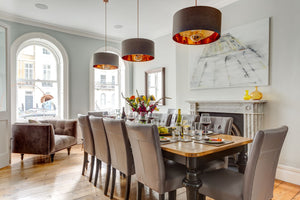Picking the correct cornice for your project can sometimes be a challenging process, but simply considering a few factors can help make the entire experience much more enjoyable, writes Jane ffrench Mullen of The Old Mould Company Ltd.

1. Take your time
The very first thing to remember is to take your time and to pick a cornice or coving for your room that appeals to your own personal taste. We cannot stress enough that, despite whatever the age or design of your building may be – ALWAYS pick something you like to look at. Cornice and coving, once fitted, is not designed to come down again (It can be replaced – but this is a dusty and messy procedure), so taking a few moments to consider your options is well worth while. To this end, ask us for samples, as often, a small sample tacked up on your ceiling and wall can make all the difference in choosing your cornice design.
2. Ceiling Height
One important consideration when selecting a cornice or coving is the height of your ceiling. While there are no hard and fast rules regarding cornice size, choosing a cornice that is too small or too big for your room can throw off the proportions of your design so it is vital to work out your ceiling height and then pick a cornice or coving that is suitable for your room. For example – if your ceiling height is 2.4m (which is the usual standard height of a ceiling in Ireland) you would be looking at a cornice that is somewhere in the range of 75mm-130mm projection along the ceiling and 75mm to 130mm depth down along your wall.
3. Size of your Room
When selecting a cornice or coving, the size of your room is a consideration. If you have a small lobby or office, with a standard height ceiling, it is advisable to consider smaller cornices or coving as something too large will make the room feel cramped. Rather than enhancing your room, too large a cornice will make the room feel small and bring the ceiling down visually. If you have a low ceiling but a large room, maybe consider a cornice that has more of a projection along the ceiling, and less down along the wall – for example the Small Gem Cornice or the Belgravia Cornice – as this will compliment the existing proportions of the room and give you the feature you are looking for without lowering your ceiling.
4. Overall design of the room/property
Bearing in mind that you should always pick something you like, it can be helpful to consider the age of the property that you are looking to decorate. Is it a modern home or office, or is a period property? Is it a new build but you are looking to add some period features to? As a general rule, plain cornice is more modern and cornice with decorative features like egg and dart or grape and vine designs is a more period style. Although, this rule has been broken so many times it barely qualifies as a rule anymore! There are plenty of Georgian, Victorian and Edwardian properties with original plain cornice, and plenty of new homes with beautiful decorative moulding. The main consideration is to pick a cornice or coving that fits in with the overall design and feel of your project.
5. Is there anything in the way?
Sometimes window frames or door frames, lights or even attic doors or built in furniture can restrict the amount of wall or ceiling available to take a cornice or coving, so before finalising your design choice, make sure that you have the necessary space available for your preferred cornice choice.

